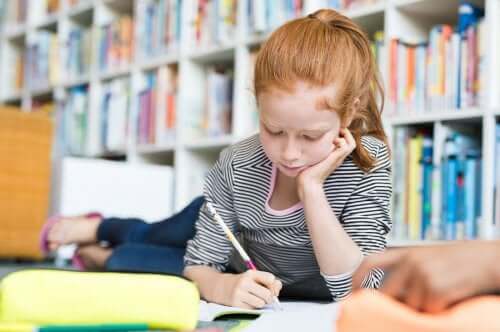3 Activities to Foster Concentration in the Classroom

It’s common for children and teens to become easily distracted in class. This can happen due to many factors. The duration of students’ attention spans varies depending on age, motivation, time of day, and subject. Below, discover three activities to foster concentration in the classroom.
As children grow, their attention span increases. However, you can train them to improve their concentration and attention at any age. For that purpose, there are many strategies and methodologies teachers can use. Below, we’ll see examples of activities to foster concentration in the classroom.
Perform a routine before starting the class
Before starting class or giving instructions to do an activity, it’s highly recommended for the teacher to perform a routine. This will help students prepare their brains for the class that’s about to start and stimulate their concentration.
This routine will mark the end of relaxation time and the beginning of a period of learning that will require more attention. If the students repeat it every day, they’ll get used to it and the transition will be easier.
The first thing to do is to achieve total silence. For this purpose, it’s very useful to tell the students that they’ll be allowed to talk among themselves for a few minutes and that they’ll then be given a signal indicating that the period of silence will begin.
The signal can be simply counting to three. You can also use a bell or some other sound. It’s also important to teach students that, besides silence, the signal also indicates that they should sit upright, looking forward.

Mental exercises to foster concentration
To get the students’ attention, it’s advisable to do some mental exercises. These can also be done between learning cycles or when you notice that the class has lost concentration. There are many activities to foster concentration in the classroom.
The tortoise technique is one of the classics. It consists of telling children or adolescents the story of the tortoise, which you can easily find online. You should ask them to put their head between their shoulders and stay still every time they hear the word “tortoise”, imitating this animal when it’s inside its shell.
“It’s essential to plan 15 to 20 minute blocks. Beyond that time, the students will fail to keep their attention.”
Another widely used strategy is the box game, which consists of showing students a series of objects and then putting them inside a box. Then, you need to ask them to name the objects that are inside the box one by one. In addition to fostering concentration, this exercise helps to strengthen memory.
On the other hand, you can resort to playful elements that help boost concentration in the classroom. These include puzzles, spot the differences games, word searches, and memory games, among others.
All these activities are great tools for teachers to help students develop their attention span. The important thing is to not always use the same games and try to make them as fun as possible.

Creating an enabling environment and avoiding distractions
For children to better focus in the classroom, it’s important to create a suitable environment for them. The classroom should be well lit, ventilated, silent, and with a pleasant temperature. Also, distractions should be avoided as much as possible.
For example, it’s important for the teacher to prepare all the material in advance. The comings and goings to seek materials are a source of distraction that make it very difficult for students to stay focused.
To foster concentration in the classroom, it’s essential to plan 15 to 20 minute blocks. Beyond that time, the students will fail to keep their attention and will start to become distracted. This system will also facilitate information processing.
Finally, it’s also important to control the level of difficulty of the attention task that’s being demanded of them. An overly difficult or easy activity will lead to a lack of attention.
It’s common for children and teens to become easily distracted in class. This can happen due to many factors. The duration of students’ attention spans varies depending on age, motivation, time of day, and subject. Below, discover three activities to foster concentration in the classroom.
As children grow, their attention span increases. However, you can train them to improve their concentration and attention at any age. For that purpose, there are many strategies and methodologies teachers can use. Below, we’ll see examples of activities to foster concentration in the classroom.
Perform a routine before starting the class
Before starting class or giving instructions to do an activity, it’s highly recommended for the teacher to perform a routine. This will help students prepare their brains for the class that’s about to start and stimulate their concentration.
This routine will mark the end of relaxation time and the beginning of a period of learning that will require more attention. If the students repeat it every day, they’ll get used to it and the transition will be easier.
The first thing to do is to achieve total silence. For this purpose, it’s very useful to tell the students that they’ll be allowed to talk among themselves for a few minutes and that they’ll then be given a signal indicating that the period of silence will begin.
The signal can be simply counting to three. You can also use a bell or some other sound. It’s also important to teach students that, besides silence, the signal also indicates that they should sit upright, looking forward.

Mental exercises to foster concentration
To get the students’ attention, it’s advisable to do some mental exercises. These can also be done between learning cycles or when you notice that the class has lost concentration. There are many activities to foster concentration in the classroom.
The tortoise technique is one of the classics. It consists of telling children or adolescents the story of the tortoise, which you can easily find online. You should ask them to put their head between their shoulders and stay still every time they hear the word “tortoise”, imitating this animal when it’s inside its shell.
“It’s essential to plan 15 to 20 minute blocks. Beyond that time, the students will fail to keep their attention.”
Another widely used strategy is the box game, which consists of showing students a series of objects and then putting them inside a box. Then, you need to ask them to name the objects that are inside the box one by one. In addition to fostering concentration, this exercise helps to strengthen memory.
On the other hand, you can resort to playful elements that help boost concentration in the classroom. These include puzzles, spot the differences games, word searches, and memory games, among others.
All these activities are great tools for teachers to help students develop their attention span. The important thing is to not always use the same games and try to make them as fun as possible.

Creating an enabling environment and avoiding distractions
For children to better focus in the classroom, it’s important to create a suitable environment for them. The classroom should be well lit, ventilated, silent, and with a pleasant temperature. Also, distractions should be avoided as much as possible.
For example, it’s important for the teacher to prepare all the material in advance. The comings and goings to seek materials are a source of distraction that make it very difficult for students to stay focused.
To foster concentration in the classroom, it’s essential to plan 15 to 20 minute blocks. Beyond that time, the students will fail to keep their attention and will start to become distracted. This system will also facilitate information processing.
Finally, it’s also important to control the level of difficulty of the attention task that’s being demanded of them. An overly difficult or easy activity will lead to a lack of attention.
All cited sources were thoroughly reviewed by our team to ensure their quality, reliability, currency, and validity. The bibliography of this article was considered reliable and of academic or scientific accuracy.
- Worth, S. E. (2008). Storytelling and narrative knowing: An examination of the epistemic benefits of well-told stories. Journal of Aesthetic Education, 42(3), 42-56. https://www.jstor.org/stable/25160289
- Farrell, C. H., & Nessel, D. D. (1982). Effects of Storytelling: An Ancient Art for Modern Classrooms.
- Agosto, D. E. (2016). Why storytelling matters: Unveiling the literacy benefits of storytelling. Children and Libraries, 14(2), 21-26. https://journals.ala.org/cal/article/view/5990
- Joe L. Frost, Sue Clark Wortham and Robert Stuart Reifel. (2001). Play and child development. Merrill, Prentice Hall.
-
Duncan, G. J., & Magnuson, K. (2011). The nature and impact of early achievement skills, attention skills, and behavior problems. Whither opportunity, 47-70.
-
Ericsson, I. (2008). Motor skills, attention and academic achievements. An intervention study in school years 1–3. British Educational Research Journal, 34(3), 301-313.
-
Jensen, E. (2009). Teaching with poverty in mind: What being poor does to kids’ brains and what schools can do about it. ASCD.
- Cadavid Castro, Martha Alicia. (2009). “Inteligencia, alimentación y nutrición en la niñez: revisión.” Perspect. nutr. hum 11.2 (2009): 187-201.
- Martin, A., Booth, J. N., Laird, Y., Sproule, J., Reilly, J. J., & Saunders, D. H. (2018). Physical activity, diet and other behavioural interventions for improving cognition and school achievement in children and adolescents with obesity or overweight. The Cochrane Database of Systematic Reviews, 3(3), CD009728. https://www.cochranelibrary.com/cdsr/doi/10.1002/14651858.CD009728.pub3/abstract?cookiesEnabled
This text is provided for informational purposes only and does not replace consultation with a professional. If in doubt, consult your specialist.








